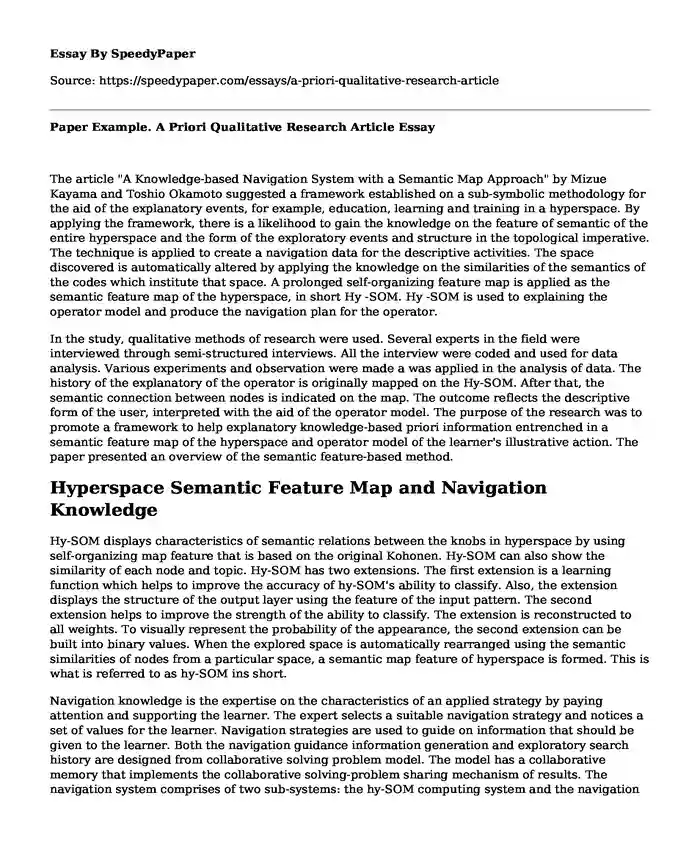
| Type of paper: | Essay |
| Categories: | Knowledge Data analysis Technology |
| Pages: | 3 |
| Wordcount: | 585 words |
The article "A Knowledge-based Navigation System with a Semantic Map Approach" by Mizue Kayama and Toshio Okamoto suggested a framework established on a sub-symbolic methodology for the aid of the explanatory events, for example, education, learning and training in a hyperspace. By applying the framework, there is a likelihood to gain the knowledge on the feature of semantic of the entire hyperspace and the form of the exploratory events and structure in the topological imperative. The technique is applied to create a navigation data for the descriptive activities. The space discovered is automatically altered by applying the knowledge on the similarities of the semantics of the codes which institute that space. A prolonged self-organizing feature map is applied as the semantic feature map of the hyperspace, in short Hy -SOM. Hy -SOM is used to explaining the operator model and produce the navigation plan for the operator.
In the study, qualitative methods of research were used. Several experts in the field were interviewed through semi-structured interviews. All the interview were coded and used for data analysis. Various experiments and observation were made a was applied in the analysis of data. The history of the explanatory of the operator is originally mapped on the Hy-SOM. After that, the semantic connection between nodes is indicated on the map. The outcome reflects the descriptive form of the user, interpreted with the aid of the operator model. The purpose of the research was to promote a framework to help explanatory knowledge-based priori information entrenched in a semantic feature map of the hyperspace and operator model of the learner's illustrative action. The paper presented an overview of the semantic feature-based method.
Hyperspace Semantic Feature Map and Navigation Knowledge
Hy-SOM displays characteristics of semantic relations between the knobs in hyperspace by using self-organizing map feature that is based on the original Kohonen. Hy-SOM can also show the similarity of each node and topic. Hy-SOM has two extensions. The first extension is a learning function which helps to improve the accuracy of hy-SOM's ability to classify. Also, the extension displays the structure of the output layer using the feature of the input pattern. The second extension helps to improve the strength of the ability to classify. The extension is reconstructed to all weights. To visually represent the probability of the appearance, the second extension can be built into binary values. When the explored space is automatically rearranged using the semantic similarities of nodes from a particular space, a semantic map feature of hyperspace is formed. This is what is referred to as hy-SOM ins short.
Navigation knowledge is the expertise on the characteristics of an applied strategy by paying attention and supporting the learner. The expert selects a suitable navigation strategy and notices a set of values for the learner. Navigation strategies are used to guide on information that should be given to the learner. Both the navigation guidance information generation and exploratory search history are designed from collaborative solving problem model. The model has a collaborative memory that implements the collaborative solving-problem sharing mechanism of results. The navigation system comprises of two sub-systems: the hy-SOM computing system and the navigation information generation system. The computing system designs educational hypermedia. The semantic attributes of links and nodes are embedded in hypermedia. The navigation information generation system contains three navigation guidance information that explores the map of learner's exploratory history and educational hypermedia.
Reference
Kayama, M., & Okamoto, T. (2017). A knowledge-based navigation system with a semantic map approach. Educational Technology & Society, 4(2), 96-102.
Cite this page
Paper Example. A Priori Qualitative Research Article. (2023, Nov 24). Retrieved from https://speedypaper.com/essays/a-priori-qualitative-research-article
Request Removal
If you are the original author of this essay and no longer wish to have it published on the SpeedyPaper website, please click below to request its removal:
Popular categories




